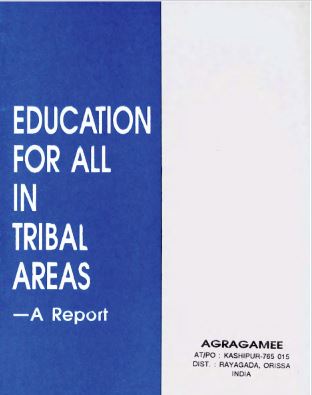Education for All in tribal areas has been a topic of discussion and debate for many years. The Agragamee publication in 1993, titled “Essay Book Education for All in Tribal Areas” sheds light on the problems faced by tribal communities in accessing quality education. This sub-report aims to summarize the key points discussed in the publication and highlight the challenges that need to be addressed to ensure education for all in tribal areas.
One of the main issues highlighted in the publication is the lack of infrastructure and resources in tribal areas. Many tribal communities live in remote and isolated regions where schools are few and far between. The lack of proper school buildings, textbooks, and trained teachers hinders the educational opportunities available to tribal children. Without these basic resources, children in tribal areas are unable to receive a quality education that will prepare them for a brighter future.
Another challenge discussed in the publication is the cultural barriers that prevent tribal children from attending school. Many tribal communities have their own customs, traditions, and languages that are not reflected in the mainstream education system. As a result, tribal children may feel alienated and disconnected from the curriculum being taught in schools. This lack of cultural relevancy can lead to a disinterest in education and a high drop-out rate among tribal students.
In addition to infrastructure and cultural barriers, the publication also highlights the economic challenges faced by tribal communities. Many tribal families live below the poverty line and struggle to afford basic necessities, let alone education expenses. The cost of school fees, uniforms, and transportation can be prohibitive for many tribal families, making it difficult for their children to attend school regularly.
Furthermore, the publication discusses the lack of government support and policies tailored to address the specific needs of tribal communities. Despite government initiatives to promote education for all, tribal areas continue to lag behind in terms of educational attainment. There is a need for targeted interventions and resources that are specifically designed to support the unique needs of tribal communities and bridge the gap in educational opportunities.
In conclusion, the Agragamee publication on “Essay Book Education for All in Tribal Areas” sheds light on the challenges faced by tribal communities in accessing quality education. From infrastructure and cultural barriers to economic challenges and lack of government support, there are a multitude of obstacles that hinder education for all in tribal areas. It is imperative that policymakers, educators, and stakeholders work together to address these challenges and ensure that every child, regardless of their background, has access to a quality education. Only then can we truly achieve education for all in tribal areas and empower tribal communities to thrive and succeed.
Books Info
| Books name | Education for All in Tribal Areas |
| Editor | Agragamee |
| No Of pages | 24 |
| Publisher | Agragamme |
| Publication | 1993 |
| Printed At | NA |
| Distributor | NA |

